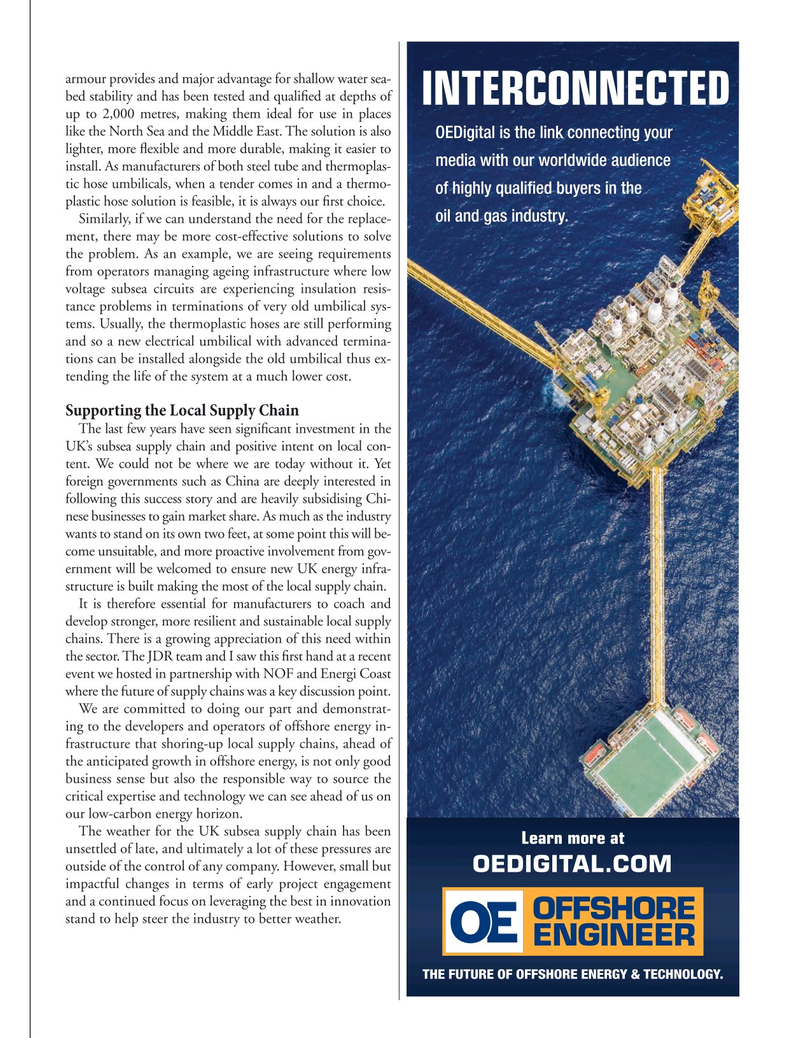
Page 55: of Offshore Engineer Magazine (Mar/Apr 2024)
Read this page in Pdf, Flash or Html5 edition of Mar/Apr 2024 Offshore Engineer Magazine
armour provides and major advantage for shallow water sea- bed stability and has been tested and qualifed at depths of
INTERCONNECTED up to 2,000 metres, making them ideal for use in places like the North Sea and the Middle East. The solution is also
OEDigital is the link connecting your lighter, more fexible and more durable, making it easier to media with our worldwide audience install. As manufacturers of both steel tube and thermoplas- tic hose umbilicals, when a tender comes in and a thermo- of highly qualified buyers in the plastic hose solution is feasible, it is always our frst choice. oil and gas industry.
Similarly, if we can understand the need for the replace- ment, there may be more cost-effective solutions to solve the problem. As an example, we are seeing requirements from operators managing ageing infrastructure where low voltage subsea circuits are experiencing insulation resis- tance problems in terminations of very old umbilical sys- tems. Usually, the thermoplastic hoses are still performing and so a new electrical umbilical with advanced termina- tions can be installed alongside the old umbilical thus ex- tending the life of the system at a much lower cost.
Supporting the Local Supply Chain
The last few years have seen signifcant investment in the
UK’s subsea supply chain and positive intent on local con- tent. We could not be where we are today without it. Yet foreign governments such as China are deeply interested in following this success story and are heavily subsidising Chi- nese businesses to gain market share. As much as the industry wants to stand on its own two feet, at some point this will be- come unsuitable, and more proactive involvement from gov- ernment will be welcomed to ensure new UK energy infra- structure is built making the most of the local supply chain.
It is therefore essential for manufacturers to coach and develop stronger, more resilient and sustainable local supply chains. There is a growing appreciation of this need within the sector. The JDR team and I saw this frst hand at a recent event we hosted in partnership with NOF and Energi Coast where the future of supply chains was a key discussion point.
We are committed to doing our part and demonstrat- ing to the developers and operators of offshore energy in- frastructure that shoring-up local supply chains, ahead of the anticipated growth in offshore energy, is not only good business sense but also the responsible way to source the critical expertise and technology we can see ahead of us on our low-carbon energy horizon.
The weather for the UK subsea supply chain has been
Learn more at unsettled of late, and ultimately a lot of these pressures are outside of the control of any company. However, small but
OEDIGITAL.COM impactful changes in terms of early project engagement and a continued focus on leveraging the best in innovation stand to help steer the industry to better weather.
THE FUTURE OF OFFSHORE ENERGY & TECHNOLOGY.

 54
54

 56
56